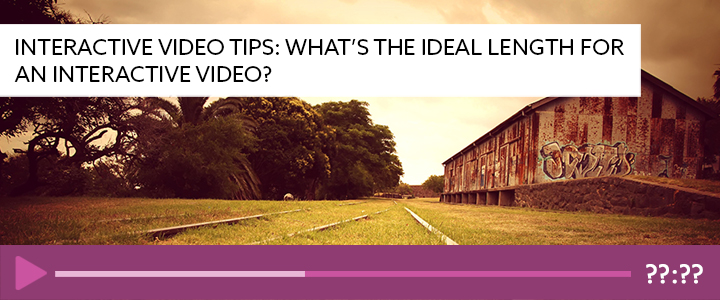
What’s the ideal length of an Interactive Video? It’s a funny question actually. Would you ask how many stanzas a love poem should have, or what the perfect number of explosions would be for an action film? How about the ideal number of colors in the perfect painting, or the best canvas size?
Interactive Video (IV), like all other creative tools, is simply a new medium for expressing thoughts, emotions, and stories. It is limited only by human imagination and the will to make something that has never been made. From short call-to-action videos that encourage viewer participation to a deeply immersive IV profile of a social issue, the possibilities for success with this new medium are huge.
A great Interactive Video is like a great piece of music – it can elicit emotion, convey a message, get people moving, teach, relax, enlighten, and delight. And like music, while an IV can be any length (some great ones provide a deep content journey), there is a certain recognizable structure found in most successful IVs. Like music, these are usually in the range of 90 seconds to 5 minutes and contain a hook, story development, a climax, and a resolution.
Keep in mind that these are just suggestions and great stories are capable of being told in different ways.
THE HOOK
VIDEO LENGTH NO MORE THAN 45 SECONDS AND ONE CHOICE POINT
We are accustomed to a certain pacing with storytelling, as we are with music, and it’s helpful to think about your Interactive Video project within that structure. Because there is so much content to watch, listen to, and experience online, you’re going to have to capture your audience fairly quickly.
The hook is a convention that entices folks to read more, watch more, or listen longer, and it’s equally important in all three cases. With Interactive Video, however, you have a third dimension at your disposal to capture your audience. Adding a great music track to compelling visuals for an emotional tie is a classic formula to engage audiences quickly, but imagine marrying that scene with a choice point, offering an opportunity for viewers to physically engage with the storyline.
Your hook serves as an invitation to participate, driving the outcome of the story or directing how the content is delivered. As soon as the viewer clicks, you have made that connection to what they really want to see – and you can supply it.
STORY DEVELOPMENT
VIDEO LENGTH NO MORE THAN 3 MINUTES AND NO MORE THAN THREE CHOICE POINTS
This is the meat of the story where you develop the character or storyline introduced in the hook. Whether a character or a product, you can offer a back story, additional dimensionality, and scenarios that help the viewer learn more. With choice points, you can empower the viewer to explore the dimensions that most interest them.
A 30-second-long clip is usually enough to establish setting and the start of a personality reveal. You can then offer a choice point to further engage the viewer. Day or night, outside or inside, tech specs or fun stuff, Prius or Wrangler – these choices allow the viewer to play out their preferences in the story while allowing the content creator to further develop the story they envision.
Three options per choice point is usually the most you will want to include so as not to overwhelm the viewer or overcomplicate the story. Each choice will play out an alternate extension to the leading node and can continue to branch out or can re-connect at a common storyline.
One example I’ve been thinking about since I first saw the Rapt Media platform is a “Boy Meets Girl” romance where the two first exchange looks on the subway. At that point you can choose to follow either the boy or the girl, and see how their lives continue to play out. The two meet a second time, and the viewer gets to once again choose who to follow. The viewer can weave seamlessly between two disparate storylines that periodically come together at inflection points, and there’s incentive to watch again to see what you might’ve missed.
CLIMAX
VIDEO LENGTH NO MORE THAN 45 SECONDS AND NO MORE THAN ONE CHOICE POINT
Something exciting needs to happen to justify that hook you threw out at the beginning of the experience. One of the most exciting parts about Interactive Video is that you can build actionable cliffhangers into your project. From the example above: you chase the girl to the airport and she’s headed through security. You kiss, she smiles, wipes a tear from her face, and turns away toward the gate.
Was that it? Do you let her go, or do you run to buy a ticket and follow? Give the viewer some reason to follow through, give the choice some weight, and reward the viewer with something profound, funny, or insightful on the other end.
RESOLUTION
VIDEO LENGTH NO MORE THAN 1 MINUTE AND ONLY ONE CHOICE POINT
This is the point where you wrap up the story and offer a call to action. An online Interactive Video’s conclusion is an opportunity to get the viewer engaged more deeply in your brand, story, future content, or community, as opposed to just an ending. The resolution can tease additional upcoming content, inspire sharing through social channels, and give the viewer added value (a coupon or MP3 maybe). The viewer is left wanting to share and wanting more.
Imagine a closeup of clenched fists that slowly relax in surrender as, in slow motion, the boy turns away from airport security and toward the exit. The camera pulls up and we see the two slowly walking in opposite directions. The video shows a split screen closeup of his eyes on one side, her eyes on the other, and then it cuts to black. “What next? Click here to share through social, watch again, or be notified about the next chapter.”
As I mentioned above, this is just one way for an interactive story to play out, and I offer it up as a template for getting started. As you get into your story you’ll see what parts work for you and which you should change. That’s progress!
Also, keep in mind that while this works for narrative stories, there are menu-driven Interactive Videos that call for a different sort of thinking … but we’ll save that for a future post.
Have any questions about Interactive Video you’d like answered? Drop them in the comments below and we’ll add them to our list of IV Tips. See you next week!
Editor’s Note 3/14/14: Check out IV Tips 3: How to create and leverage menu-driven Interactive Videos. Missed Week 1 of our Interactive Video Tips series? Check it out here: Where should I put my first choice point?






